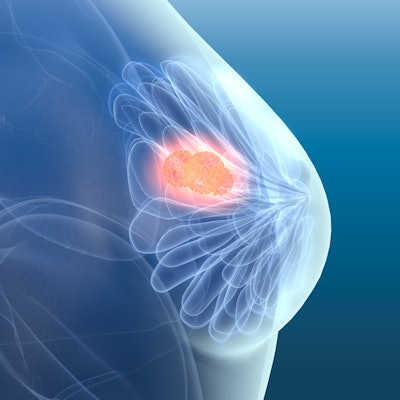
Women who had cancer in childhood treated with chest radiotherapy may strongly benefit from annual breast cancer screening starting in their 20s, according to a study published on July 6 in the Annals of Internal Medicine. Annual screening as early as age 25 could reduce breast cancer deaths in these women by more than 50%.
The U.S. National Institutes of Health and American Cancer Society funded the study, which is one of the first to estimate breast screening harm-benefit ratios for those with a history of childhood cancer. The results support the Children's Oncology Group (COG) recommendation that women with prior chest radiation begin annual mammography and breast MRI screening at age 25.
"Our findings underscore the importance of making sure that young women previously treated with chest radiation are informed about their elevated breast cancer risk and the benefits of routine screening," wrote the authors, led by Jennifer Yen, PhD, from the division of general pediatrics at Boston Children's Hospital.
An estimated 30% of women who underwent chest radiotherapy as children will develop breast cancer before the age of 50, a similar percentage to women with BRCA mutations. Despite the high cancer risk in this population, researchers have conducted few studies on the benefits, harms, and costs of conducting more frequent breast screenings for women who had cancer as children
For their study, the authors used two well-researched breast cancer simulation models. The authors adjusted the models for their specific population, then calculated the benefits and harms of performing breast screening with different modalities and starting ages.
| Averaged breast screening model predictions for women with childhood chest radiation exposure | ||||||
| Screening starts at age 35 | Screening starts at age 30 | Screening starts at age 25 | ||||
| MRI only | MRI + mammo | MRI only | MRI + mammo | MRI only | MRI + mammo | |
| Breast cancer deaths* | 50.6 | 45.9 | 45.8 | 40.5 | 43.8 | 38.3 |
| QALYs gained* | 663 | 755 | 797 | 930 | 850 | 990 |
| False-positive results* | 2099 | 2694 | 2776 | 3568 | 3524 | 4534 |
| Benign biopsy results* | 798 | 862 | 1055 | 1142 | 1339 | 1451 |
Women with childhood chest radiation exposure had an estimated 10%-11% lifetime risk of dying from breast cancer, the authors found. Routine screening reduced this risk by at least half in all models and did so with false-positive and benign biopsy rates lower than rates for women with average breast cancer risk.
The findings supported COG's current recommendation of annual mammography and breast MRI screening beginning at age 25. This combination prevented 56%-71% of breast cancer-related deaths and increased quality-adjusted life years (QALY) gained by 1,317 to 2,544 per 1,000 women.
"With this annual schedule, a survivor will have an average of four to five false-positive screening results and one to two benign biopsy results over the course of her lifetime," the authors wrote. "However, because of the large survival benefits, the harm-benefit tradeoffs for survivors seem to be appropriate, resulting in more favorable harm-benefit ratios than published benchmarks for average-risk women."
Although COG's recommendation did well in the analysis, the combination of mammography and MRI screening may be even more cost-effective when starting at age 30. Beginning screening just five years later resulted in lower costs with marginal quality-of-life losses, the authors noted.
The authors cautioned their cost estimates used 2018 Medicare reimbursement rates, which likely underestimated total costs. They also based MRI and mammography performance on studies of BRCA mutation carriers because of a lack of research on women with a history of childhood cancer.
As a result, the authors weren't able to explore all of the radiation risks related to long-term mammography screening. However, they argued potential radiation risks may not be all that relevant because their findings found mammography was more cost-effective at age 30 and because the study population already has a large amount of lifetime radiation exposure.
"Our findings suggest that even without accounting for these additional potential risks, the benefit of adding mammography to MRI screening at these young ages is uncertain, and MRI alone may be a reasonable screening strategy at younger ages," they wrote.



















